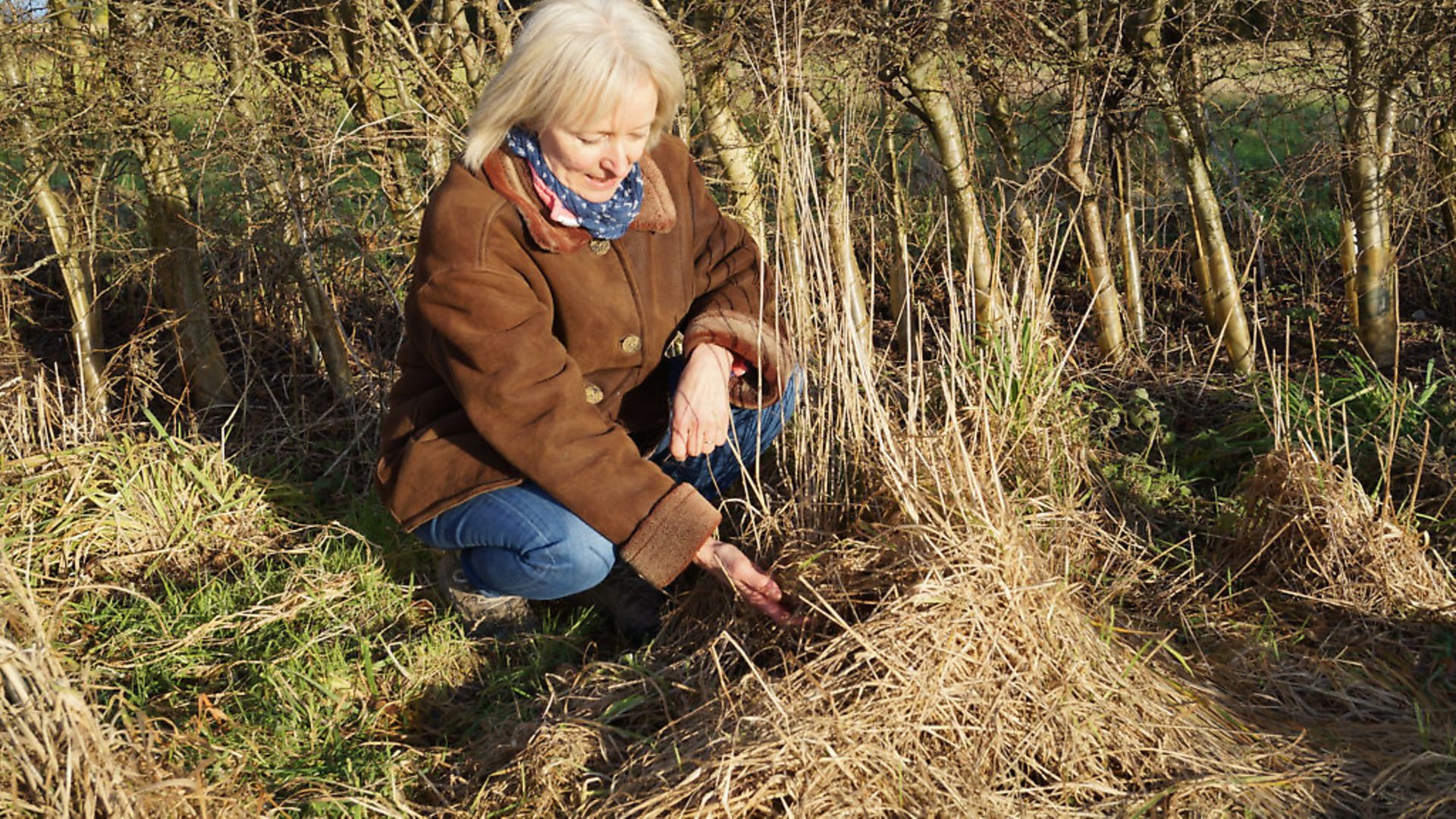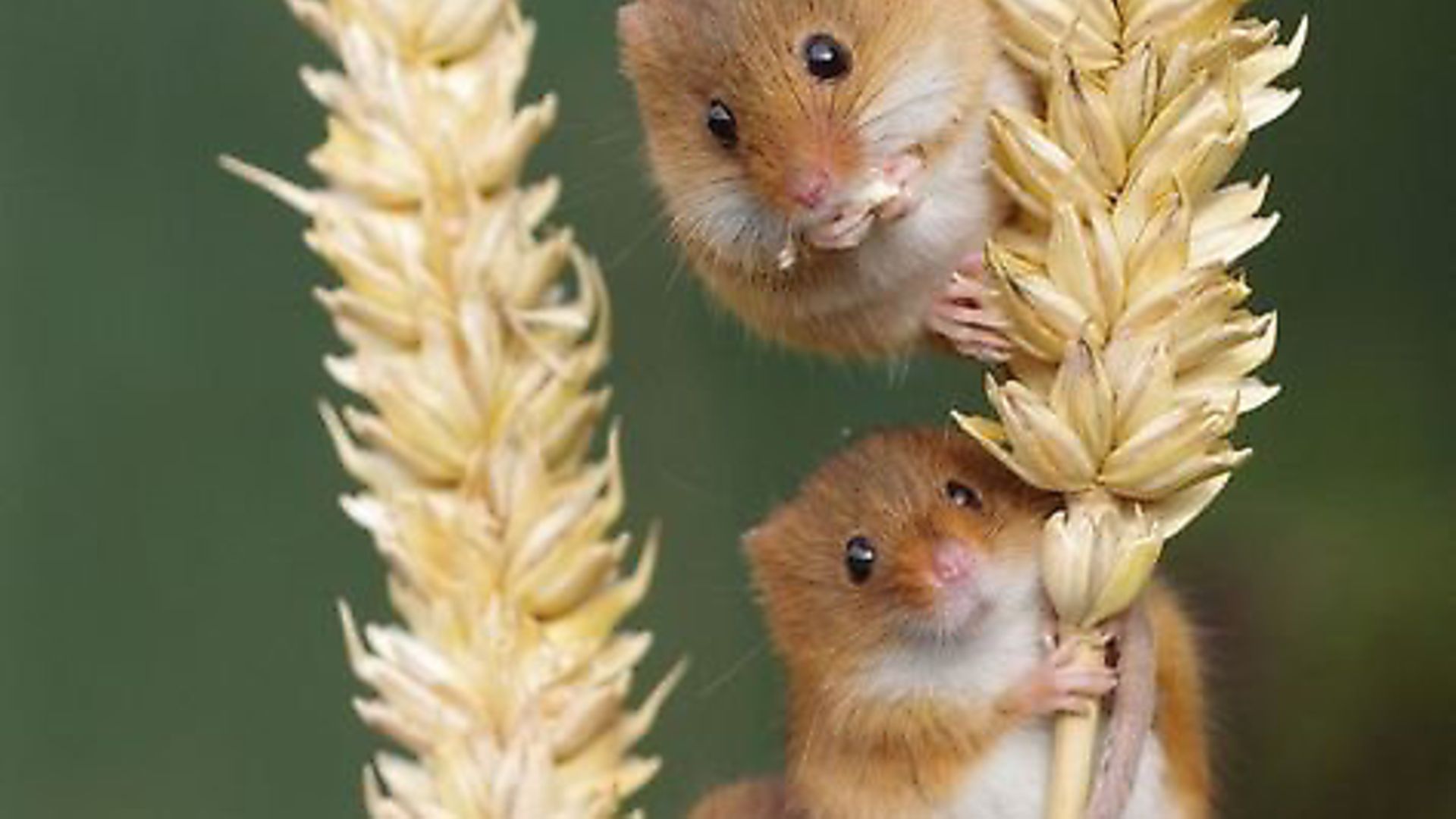Joe Dimbleby takes an in-depth look at one farmer’s successful conservation of harvest mice and the huge conservation benefits brought by Farmer Clusters
 credit: Archant
credit: Archant
Kate Faulkner helps to manage the 22% of land in conservation measures on the 700-acre Norton Farm, near Selborne on the edge of the Hampshire Weald. Her husband, Andrew, and father-in-law, Derick, run Norton, which is part of a machinery- and labour-sharing collaboration with two neighbouring farms, covering an arable area of approximately 2,800 acres, growing wheat, oilseed rape, oats, barley and beans in rotation. Kate also represents the farm on the local 10,000-acre Farmer Cluster. She explained that there had always been a keen interest in conservation in the family. "Derick used to put old tea chests up for barn owls to nest in and throughout his farming life has planted a huge number of trees, as well as restoring our 13 acres of ancient hanger woodland to good health," Kate says. "I also grew up on a farm on chalk downland in Hampshire. My dad had a particular meadow he was very proud of and whenever we went for walks he'd tell us what plant was what."
The farm first entered into Countryside Stewardship in 1998, and Kate became involved when they entered a Higher Level agreement with Natural England in 2009. All the arable fields have six metre margins of long grass, and the family has planted over 2,000m of hedgerow in the past 20 years. There are 97 acres of 'low input' grassland, which means chemical application is limited. These are grazed by sheep, making it an ideal site for breeding lapwings from a nearby nesting plot to bring their chicks to feed. There is no shoot on the farm, but Derick puts out Larsen traps for corvids in the spring to protect nesting songbirds and has installed 10 barn owl boxes.
Norton Farm has been part of the Selborne Landscape Partnership Farmer Cluster since 2014, when it was started by local farmer William Wolmer. It now involves 16 farmers co-ordinating conservation initiatives across 10,000 acres around the village of Selborne. The Cluster benefits from including the adjacent GWCT demonstration project at Rotherfield Park, which shows how to re-introduce grey partridge where they have gone extinct and the wider benefits this has for farmland biodiversity. This includes testing habitat measures such as cover crops and wild bird seed mixes aimed at partridges.
Chief scientist at Rotherfield, Francis Buner, attends all the Cluster meetings and visits its farms to provide advice. Kate explained the value of his involvement: "Our Cluster has been on numerous farm walks at Rotherfield. It really is a gold-standard showcase, so when Francis came out last November, I thought his suggestions might be over the top, but they were actually very achievable. I'm a big fan of the GWCT; they can show scientific proof of how their conservation measures are benefiting wildlife and their advisors are very practical and can see things from a farming perspective. A collaborative approach is far more appealing than being dictated to."
For one of its first projects, the Cluster chose to improve habitat for harvest mice, inspired by the famous 18th-century naturalist Gilbert White, who lived in nearby Selborne and identified the harvest mouse as a separate species.
In 1999, only one harvest mouse nest was recorded around the village of Selborne; in 2014, teams counted 472 separate nests across the Cluster. Inspired by the project, the Faulkners decided to improve their hedgerows. One 10-year-old hawthorne hedge was straggly at the bottom and was letting the wind through at the base, so they invited Rob Nichol, a South Downs National Park ranger, to organise a weekend's training for farmers to learn how to cut and lay hedges to provide better nesting habitat for harvest mice.
If you do something for one species, it often helps others. In this case, whitethroats and yellowhammers, which nest low down in hedgerows, now benefit from increased insect life and protection from predators.
According to Kate, the farm received little recognition for its conservation work until it joined the Farmer Cluster, but the resulting higher profile has enabled them to inspire others in a way that wouldn't be possible as a single farm. For example, South Downs National Park volunteers came and finished the full length of cut-and-layed hedge started by the Cluster, and the fact that the hedge was on a footpath drew in the village of Farringdon and encouraged others to get their hedges layed.
Kate says: "Much of the recognition for the harvest mouse project was down to the GWCT. Peter Thompson was instrumental in getting DEFRA secretary of state Liz Truss to visit us in 2016, and that led to high-profile interest from national papers and radio stations. We were counting our harvest mice around the time that the State of Nature report came out, and I felt despondent about the reported declines in wildlife, which is a shame because there is so much going on. I worry people still think we are all ripping out hedgerows, but that hasn't been the case since the '80s.
 credit: Archant
credit: Archant
"There are also many environmental benefits of having more sophisticated machinery. For example, nowadays sprayers can be operated with much more precision, significantly reducing the amount of chemical used. This greater efficiency in the middle of the field allows us to have a bit more mess round the edges, which is good for wildlife."
Kate believes that compromises can be found between the conflicts of modern farming and conservation. At one stage, they decided against having lapwing and skylark plots in the centre of the arable fields as it was too difficult to manage, but she is confident that, through good communication, most options can be accommodated. For example, you can site a beetle bank to suit the drill widths and boom length of the sprayer and all the tractors have a map of the field margins in the cab to flag them up to operators.
So, if it's possible to run a viable farming business and have space for wildlife, what stops more farmers getting involved? Kate says: "I'm sure it's a lot about time. Farming gets ever more bureaucratic with health and safety regs, employment law and so on. In the new stewardship schemes, there's requirements to record what you are doing, adding a whole new layer of paperwork. Success relies on building rapport; you need to trust the people you're dealing with otherwise it becomes adversarial very quickly. We have been in HLS for eight and a half years and during that time we have had six different Natural England advisors. I think it is important to have continuity of advice and the ability to build a good working relationship. Another stumbling block can be inflexible restrictions. Early on in our agreement, we had a two-hectare field containing both bird seed and pollen-and-nectar mixes. Because we slightly miscalculated and planted more of one than the other, we were penalised, even though both options paid the same."
In spite of the challenges, Kate is positive about the future for wildlife in the area. Along with the rest of the Cluster, the farm is planning to cut and lay more hedges and incorporate a supplementary feeding stewardship option where grain is spread for birds during winter months, something not yet tried on a landscape scale. They will also be learning how to do an official hare count, which will help the preservation of the species in the area, and work with Rotherfield to boost lapwings, the rare Duke of Burgundy and brown hairstreak butterflies and the harvest mice. Kate's advice for fellow working conservationists is: "It helps to collaborate, to talk to your neighbours and to get guidance from the GWCT. It's to do with getting advice from people who talk the same language and understand the realities of farming."
FARM FACTS
Location: Hampshire
Type of farming: Arable
Acreage: 700
Percentage in conservation: 30
Funding grants: HLS, Forestry Commission, AONB
Conservation measures: Six metre strips, woodland management, hedge planting, cutting and laying, over winter stubbles, barn owl boxes
Wildlife Highlights: Lapwing, Yellowhammer, Linnet, Song thrush, Starling, House sparrow, Stock dove, Bullfinch, Brown hare, Duke of Burgundy, Harvest mouse, Brown hairstreak
GWCT Research in Practice: Farmer Clusters
Peter Thompson, GWCT biodiversity advisor: "Farmers do a lot for Britain's rural environment, but there is only so much that an individual, acting in isolation, can do on his or her own farm. The Farmer Cluster concept, developed by the GWCT in association with Natural England, is a plan to help a number of farmers work more cohesively together in their locality, enabling them to collectively deliver greater benefits for soil, water and wildlife at a landscape scale.
"Following a pilot scheme run by the GWCT, to test if farmers would indeed work together, Natural England has put £7.8 million into a "facilitation fund". The pilot scheme found that it was important for a Farmer Cluster to have an organising conservation adviser to oversee and help implement the plan for the group.
"A Farmer Cluster is therefore designed to start life at a bottom-up, farmer level, under the guidance of a lead farmer. They devise their own conservation plans, with the help of their own chosen conservation advisors, (whom they already know and trust) who are aware of local conservation priorities.
"There are now 98 farmer clusters across England with around 1,680 farmers involved, covering 450,000 ha (1,112,000 acres)."